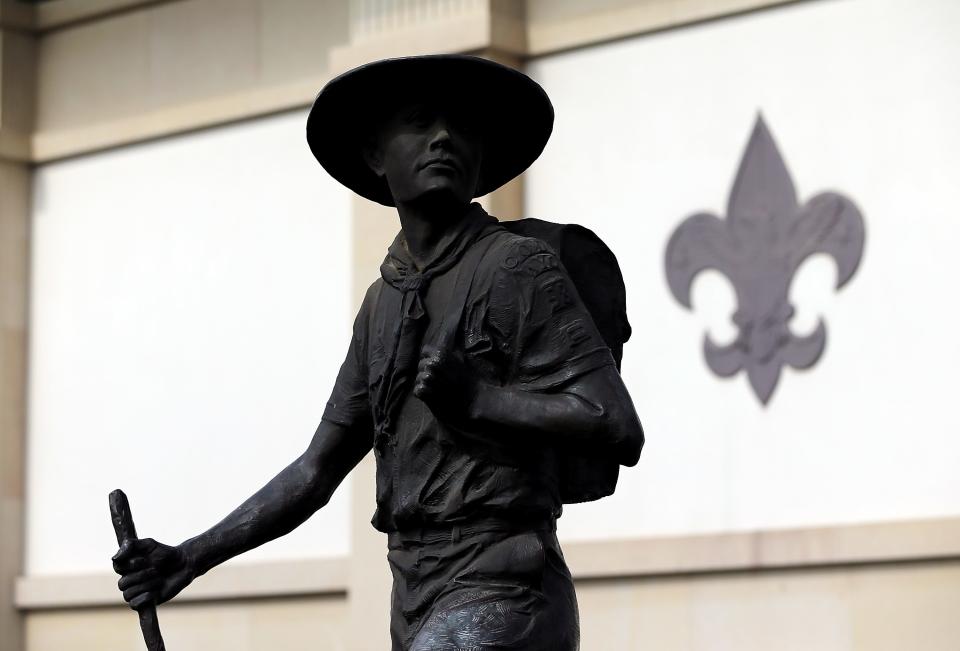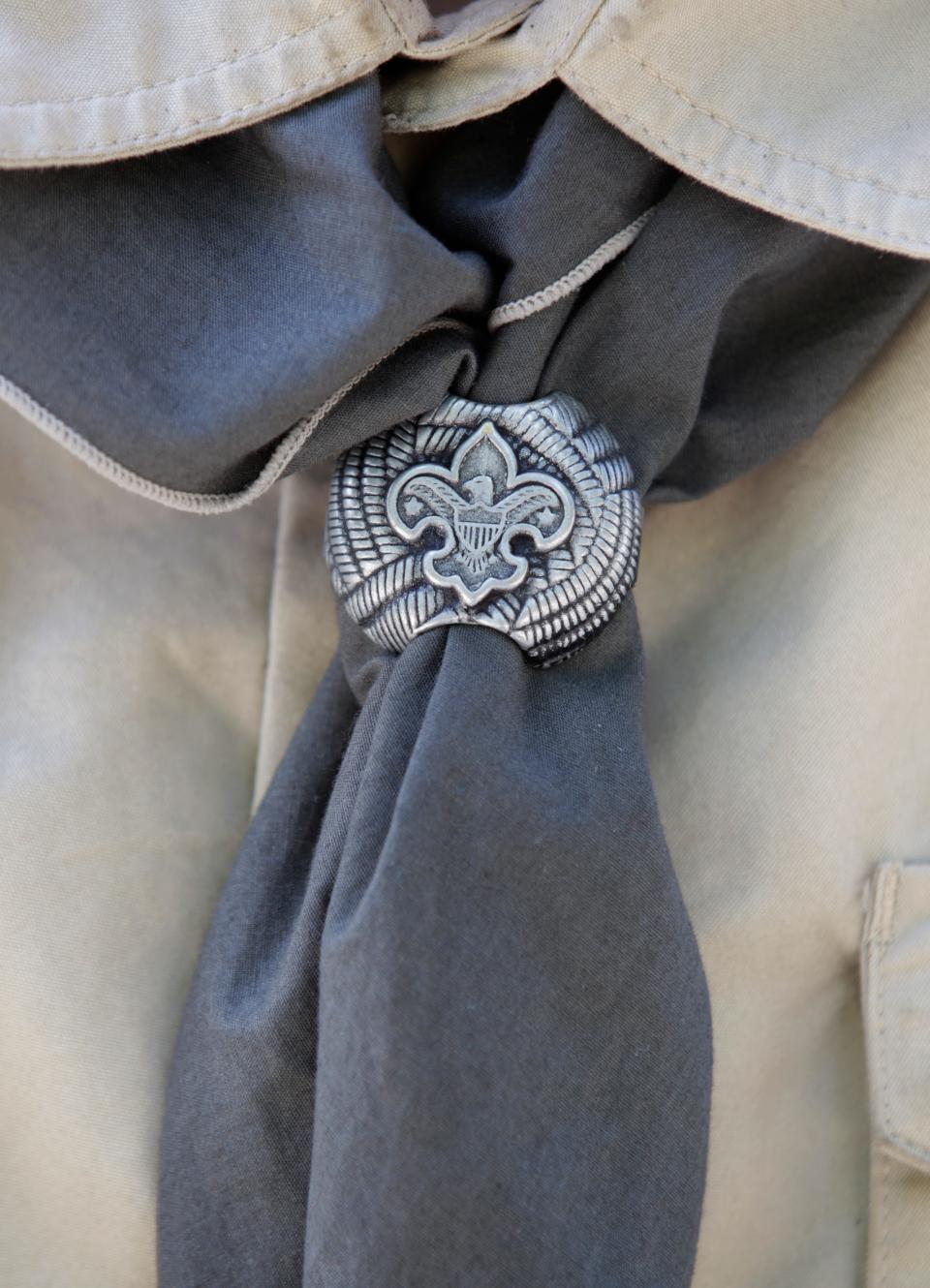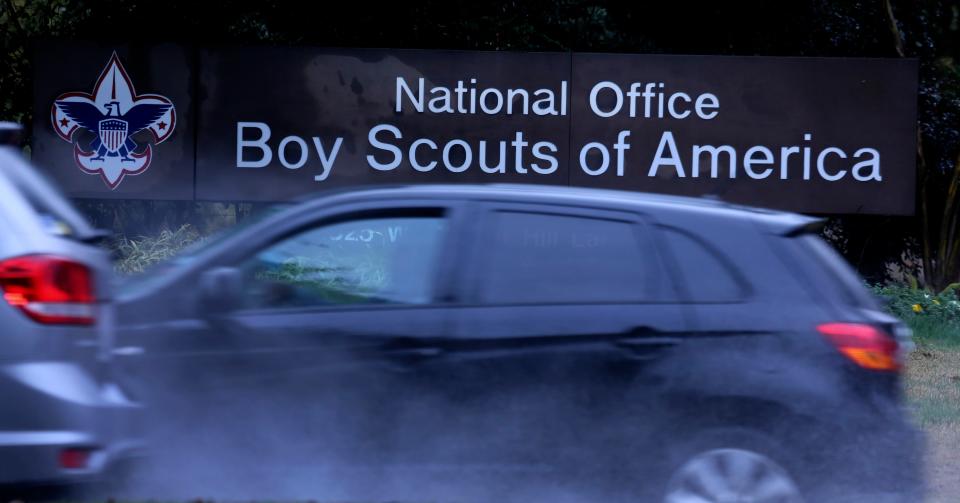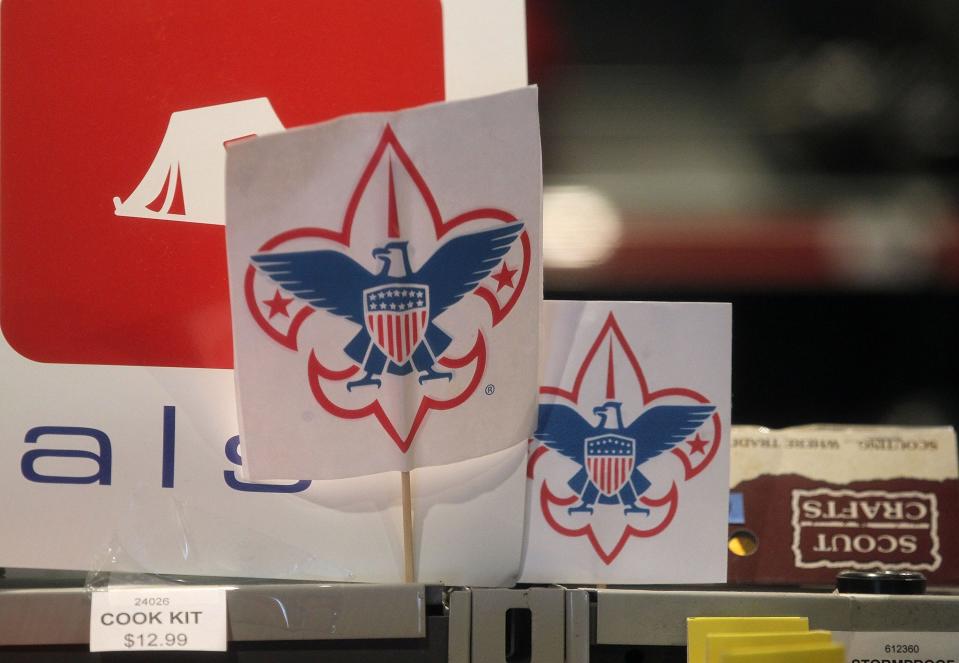Big winners in the Boy Scouts bankruptcy? Attorneys, who could walk away with $1 billion.

Like many survivors of sexual abuse, Jeffrey Chelmo didn’t get involved in the Boy Scouts of America bankruptcy case for the money. He wanted someone to be held accountable. Yet, the settlement Chelmo’s looking at under Boy Scouts’ latest proposal is hard to stomach: $3,500.
That’s less than some attorneys in the case have been charging for two hours of work, according to court records. For the month of August, one attorney with White & Case, lead counsel for Boy Scouts, billed $1,725 an hour – more than $200,000.
The case is unprecedented for bankruptcy litigation related to sexual abuse in the number of survivors filing claims (82,000), the overall amount of proposed settlement funds ($1.8 billion) and now in the proportion going to fees for everyone from attorneys to financial advisers – even lobbyists tapped by the Scouts to ward off bankruptcy reforms.
Boy Scouts of America estimates the bill for their professionals, plus those hired by the official creditors’ committees, could be more than $205 million by the end of the year. That’s approaching the amount Boy Scouts said it would contribute to a trust for survivors: $219 million.
Related video: Attorney says there's no justice in Boy Scout bankruptcy
The 82,000 who have filed sexual abuse claims in the case are scheduled to vote on the plan by Dec. 28. Approval requires a two-thirds majority. Under that plan, a majority of survivors are likely to receive $10,000 or less. Many payouts will be restricted by state laws that preclude older claims, making the flat rate option of $3,500 an attractive choice.
All told, the lawyers, financial advisors and consultants working the case could share $1 billion, according to a USA TODAY analysis.
Among the top recipients based on billing so far and elements of the proposed plan:
The two law firms that have led Boy Scouts’ legal team, White & Case LLP and Sidley Austen LLP, together have billed the nonprofit more than $26 million.
Screening claims and coordinating payouts requires other specialized teams, with costs expected to reach about $180 million.
Attorneys who represent victims typically work on contingency of one-third of a potential settlement, and as high as 40%, which would amount to at least $400 million.
The Coalition for Abused Scouts for Justice, which says it represents 63,000 survivors, stands to receive $950,000 a month in fees and a lump sum payment of $10.5 million.
Lynn LoPucki, a professor at the UCLA School of Law who studies large bankruptcies, called the entire system corrupt. Professional fees have continued to climb, he said, thanks to loopholes few are incentivized to close.
LoPucki analyzed fees in more than 100 large corporate bankruptcies filed before 2007 through a database he helped create, the UCLA-LoPucki Bankruptcy Research Database. He calculates fees as a percentage of the total assets of a bankrupt company.
He found the norm is roughly 3%, only occasionally entering double digits. Enron, which employed 64 professionals after filing for bankruptcy in 2001, had a rate of 2%. Boy Scouts’ fees are 42% of its self-reported assets.
“These are very rough benchmarks,” LoPucki said, “but I’ve never seen a case that had fees this high by that measure.”
More: Boy Scouts files Chapter 11 bankruptcy in the face of thousands of child abuse allegations
More: Boy Scouts of America sex abuse survivors claim censorship, object to bankruptcy exit plans
Earlier this year, Judge Laurie Selber Silverstein called the mounting fees in the Boy Scout case staggering and agreed to withhold 20% of them until the end of the case.
The court brought in a fee examiner, who got firms working for Scouts and the official creditors’ committees to cut $242,399 from one two-month billing cycle, according to a USA TODAY analysis of court records.
The examiner charged Boy Scouts $216,716 for his time.
Silverstein also approved Boy Scouts’ retention of several dozen “ordinary course” professionals – people the nonprofit would employ in their normal business operations outside of bankruptcy.
In October, Boy Scouts updated that list to include the 535 Group, which it said provides “government relations consulting services” and would bill the nonprofit no more than $10,000 a month. No one, including the judge or U.S. trustee in the case, objected to the addition.
The group filed paperwork with the U.S. House of Representatives last month disclosing work by a lobbyist with 535 Group – a former House member – on behalf of Boy Scouts against bankruptcy reform legislation pending in Congress.
In a statement, Boy Scouts said it “engaged 535 Group to help consult government officials related to pending legislation.”
“As a Congressionally chartered organization, it is appropriate that the BSA has a means to communication with elected officials, particularly at this pivotal time in our financial restructuring,” the statement continued, “and this requires the retention of registered lobbyists.”

Boy Scouts’ fees higher than USA Gymnastics, Catholic dioceses cases
Bankruptcy has become part of a playbook for organizations and companies seeking to limit their liability for sexual abuse. Boy Scouts is one of the latest to follow that path, paved by Catholic dioceses, USA Gymnastics and the Weinstein Company.
The Scouts filed for Chapter 11 protection in February 2020, halting all pending and future lawsuits against the nonprofit.
Steep price tags have become de rigueur in the rarified subset of high-profile bankruptcy litigation. However, USA TODAY found that costs in the Boy Scouts case are outpacing other sexual abuse bankruptcies while survivors are expected to receive fractions of the settlements afforded their counterparts in other cases.
USA Gymnastics has incurred around $17 million in fees as of September in a case filed more than a year before the Boy Scouts'. That’s roughly 20% of that nonprofit’s $84 million in reported assets.
The 500-plus survivors in that case had until Nov. 29 to vote on a plan that includes a $425 million settlement. Before expenses for vetting and distribution, it would leave an average of about $800,000 per survivor. That compares to about $19,000 under the Scouts’ plan.
Proponents of Boy Scouts’ plan say that figure could increase. Several of the Scouts’ insurance companies have not settled or disclosed the value of their policies, for instance, which could increase survivor payouts.
Another variable is the claims vetting process. The 82,000 claims filed have yet to be reviewed. If a sizable portion are missing required information, or fall short for other reasons, that could leave more for those deemed valid.
More: Boy Scouts bankruptcy update: Settlement OK'd by judge
The sheer size of the Scouts case and the scope of abuse – spanning the country and dating back almost to the group’s inception – are factors in the high costs. So is the organization’s complexity.
Boy Scouts operates under a franchise model, with a national organization coordinating 250 local councils that it says are separate legal entities. The setup also requires individual troops to be backed by sponsoring organizations like churches or civic groups.
Marie T. Reilly, a professor at Penn State Law who has analyzed the outcomes of Catholic diocese bankruptcies, said the church cases are less complicated because their structure is more straightforward.
Increased use of bankruptcy by organizations facing allegations of institutionalized child sexual abuse has given rise to a cottage industry of sorts with in-demand expertise, which experts say also can drive up fees.
“Now we have a very specialized bar, an extremely well-organized bar, with firms whose names are made in this type of work,” Reilly said.
Jeff Anderson, who represents about 800 survivors in the case, has built a reputation on sexual abuse cases against priests and groups like Boy Scouts. He’s joined by several other attorneys who have filed civil cases against the Scouts in the past: Paul Mones, Tim Kosnoff and Gilion Dumas were part of landmark cases that saw large verdicts and the release of thousands of internal Boy Scout documents known as the Ineligible Volunteer files, which the national nonprofit used to secretly track abuse allegations.
James Stang of Pachulski Stang Ziehl & Jones is representing the Tort’s Claimants Committee in the Boy Scouts case, as well as the committees in USA Gymnastics and the Weinstein Company. His unique resume has made him a sought-after presence in such cases, but his services do not come cheap, as the Washington Post reported in 2019.
Stang has billed $1,195 an hour in the Boy Scouts case, up from the $1,145 an hour he’s billed USA Gymnastics. Stang’s firm has said it will donate 10% of its fees directly to the trust for survivors. He declined to comment for this story.
The hourly rates charged by firms representing Boy Scouts are significantly higher than those charged by lawyers representing the Catholic church. The average rate charged by White & Case to Boy Scouts has been about $900 an hour. For the main law firm in the Saint Paul Archdiocese case, one of the larger Catholic diocese cases, it was below $500.
White & Case declined to comment on the record for this story. In a statement, Boy Scouts said the complexity of the case “has no doubt contributed to the time and effort expended by our advisors.”
“We appreciate the steadfast dedication of our restructuring attorneys who are working diligently around-the-clock to bring this financial restructuring process to a close as quickly as possible in a way that meets our dual imperatives of equitable compensation for survivors and the continuation of the Scouting mission – all while establishing the largest sexual abuse compensation fund in the history of the United States.”

Venue shopping one example of bankruptcy loopholes
Boy Scouts of America – an Irvin, Texas-based company incorporated in Washington, D.C., in 1910 – opened a new corporation in Delaware in July 2019.
Six months later, it filed for bankruptcy and claimed Delaware federal court as the proper venue for all its subsidiaries to file for Chapter 11 protection as well.
Such venue shopping illustrates how checks within bankruptcy law fall short, experts say, contributing to a rise in legal fees.
“The fees are extremely high in big bankruptcy cases because the law firms are spending other people’s money and the judges are supposed to be watching,” LoPucki said. “But the system has been corrupted by forum shopping, and the judges are powerless to do anything about the fees.”
Checks and balances are built into bankruptcy law. Fees incurred by lawyers, consultants and other professionals hired by the debtors, and by official committees representing creditors, can be billed to the debtor’s estate. They must be approved by the judge and reviewed by the U.S. Trustee’s Office, which oversees bankruptcy courts for the Department of Justice. Fee examiners can be brought in to provide additional oversight.
Unlike a defendant in a criminal case, who typically stands trial in a court based on the location of the crime, corporations use loopholes that allow them to file cases in courts they think will rule in their favor.
In research he presented to a House subcommittee this summer, Georgetown Law professor Adam Levitin found that nearly 80% of large, public company Chapter 11 filings in 2020 were filed somewhere other than where their headquarters were located. That left three of the country’s 375 bankruptcy judges hearing 57% of those cases.
To compete for those cases, experts say judges must be willing to authorize top dollar for attorneys’ fees. If they don’t, those cases could be filed in other courts.
“There are nine bankruptcy judges in Delaware right now. If the cases went elsewhere, there’d be one in Delaware. The other eight would lose their jobs,” LoPucki said. “That’s why I say the system is corrupt. There’s no one controlling fees, and everybody in the system knows that.”
More: Boy Scouts abuse claims may become largest case against a single national organization
More: Boy Scouts of America sex abuse survivors claim censorship, object to bankruptcy exit plans
However, something other than fees likely drove Boy Scouts to Delaware, Levitin says. Bankruptcy courts in Texas, where Boy Scouts is based, don’t allow organizations that aren’t in bankruptcy, like the local Boy Scout councils and troop sponsors, to be released from liability in exchange for a settlement. Delaware does.
Boy Scouts has relied heavily on these releases as part of its latest plan. The more than 250 local councils, some insurance companies and at least one sponsoring organization all have received releases in exchange for contributing to the trust for survivors.
Whether those groups are paying their fair share has been at the heart of disagreement throughout the case.
Those who oppose the latest plan, including the Torts Claimants’ Committee – a group of nine survivors appointed by the U.S. Trustee's Office to represent all abuse claimants – say the local councils, insurers and sponsoring organizations aren’t contributing nearly enough, which they blame for the record-low individual settlement amounts.
Many survivors, like Jeffrey Chelmo, say that’s why they’re going to vote to reject the plan.
“You need to be accountable for your actions,” he said, “and here it seems like the people that are proposing the settlement have their interests rather than an equitable accountability in mind.”

Infighting drives more activity, resulting in more billable hours
One of the more unusual developments in the Boy Scouts case has been the presence of law firms that specialize in mass tort litigation, something that Reilly said has not been a factor in previous sex abuse bankruptcies.
Those firms say they represent tens of thousands of survivors and have banded together, calling themselves the Coalition of Abused Scouts for Justice. The coalition has wrestled repeatedly with the Tort Claimants’ Committee.
The problem with the coalition, Reilly said, is that it’s not monitored in the way the committee is as an official party to the bankruptcy. Its fees aren’t reviewed by the U.S. trustee and can’t typically be billed to the Boy Scouts’ estate under bankruptcy code.
However, the current plan includes a provision for Boy Scouts to cover $950,000 per month in fees for the coalition and a lump sum payment of $10.5 million. That prompted the U.S. trustee appointed to oversee the case to file an objection. So far, the provision remains.
The infighting between the committee and the coalition has resulted in more activity in the case, which Reilly and other experts say compounds the amount of time attorneys are working and, thus, their fees.
“I’m at a loss for words for the amount of fees,” said Christopher T. Hurley of Hurley McKenna & Mertz P.C., which represents around 4,000 survivors in the case. “They’re going round and round and round and spending money on these professional fees, and victims go uncompensated. We’ll see what’s left at the end.”
Cara Kelly is a reporter on the USA TODAY investigations team, focusing primarily on pop culture, consumer news and sexual violence. Contact her at carakelly@usatoday.com, @carareports or CaraKelly on WhatsApp.
This article originally appeared on USA TODAY: Boy Scout bankruptcy racks up unprecedented fees for attorneys

 money
money 